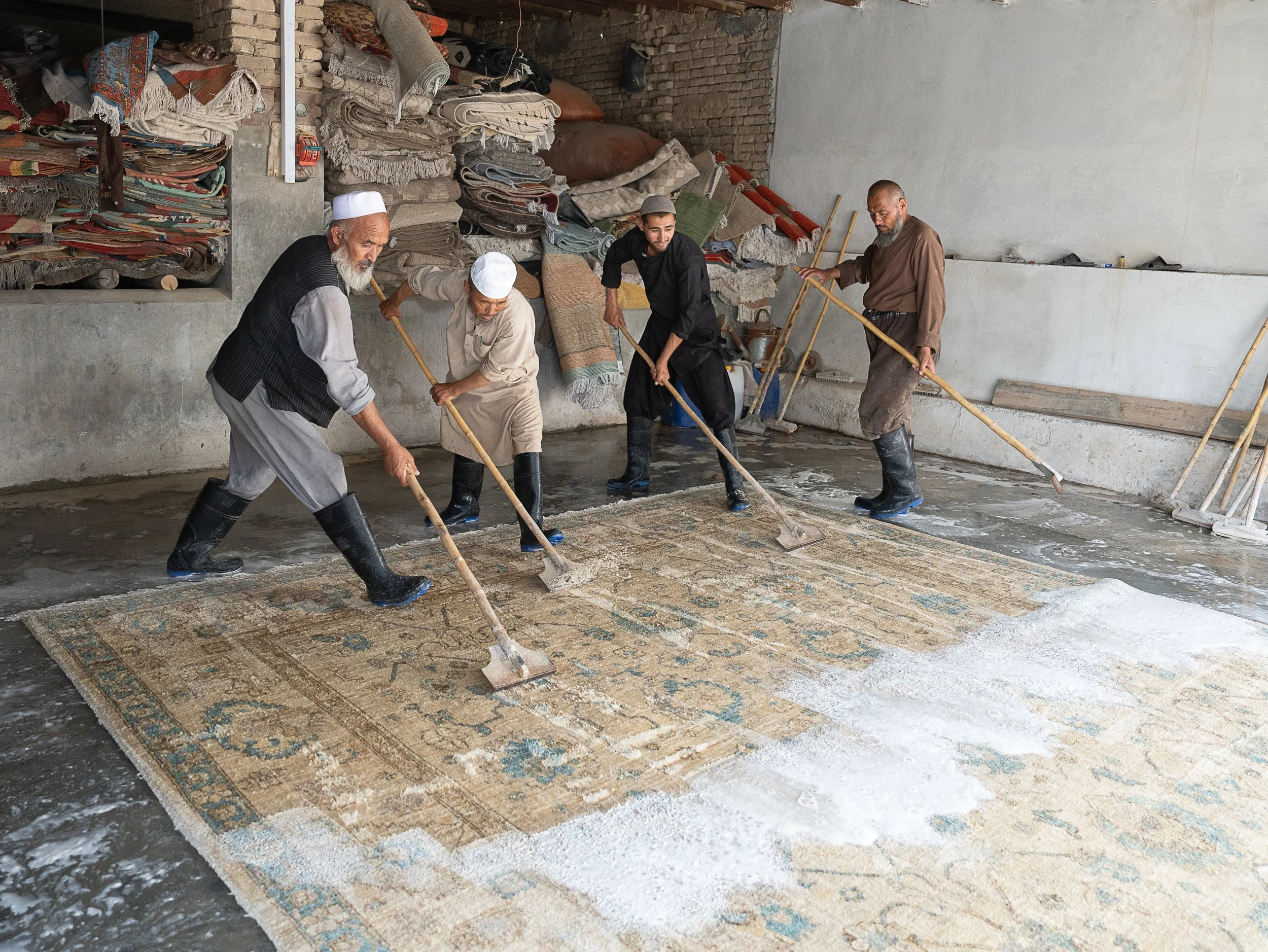Carpet making in Aqcha – the home of the Kilim
Haji Sahki posing in his wool store in Aqcha, Afghanistan.
The lure of oriental carpets suck visitors into bazaars and souks from Istanbul to Beijing. In a world of increasing ubiquity, handmade rugs offer their buyers the chance to slip into the lost world of the silk road.
Each carpet promises to tell a story, and the designs and colours convey? a tapestry of their maker’s identity. Unique hues from natural dyes and geometric quirks are readable like maps to experts, revealing where and when the rug was made and by who.
The carpet trade itself holds an incredible allure to travellers. The bazaaris and carpet sellers are deliberately coy with how they acquire their stock. Vendors allude to having purchased and selected each-and-every ‘piece’ from small family producers. Others weave tales of small merchants who travel hundreds of miles to sell them a single rug, crossing mountain ranges to cash in their savings held in a carpet in the relative metropolises of Kabul or Mazar-E-Sharif. The industry is romantically opaque.
The reality is that the carpet business is a villainous trade with every vendor claiming to offer the best prices, quality and a piece of truly local handicraft that will last a lifetime. The merchants trot out of rehearsed and well-worn yarns; most importantly friendship is priceless to them and looking is free. In reality a huge number of the dealers in places like Samarkand, Bukhara, Istanbul and Peshawar are reselling Afghan rugs made in the Turkman city of Aqcha, bought from wholesale markets in Uzbekistan, Pakistan and Turkey.
The small city two hours west of Mazar e Sharif is ground zero for Afghan Kilim production and our guests on our recent “Road to Oxiana” tour were guests at the factory that the Turquoise Mountain Foundation works with in the city to produce their world class products. These rugs and kilims are then sold to boutique designers and shops globally. If you’ve seen premium kilim products for sale in Europe and the United States, there is a high chance they were produced here.
If you’ve ever walked into a carpet factory shop and felt overwhelmed with choice, or unable to truly understand what you are buying, then a visit to Aqcha is essential.
We were guests of factory owner Haji Sahki who offered our travellers a candid look into the modern Afghan carpet trade. His factory is one of a dozen or so “finishing” factories producing hundreds of rugs a year. That doesn’t mean that any of the rugs here are mass produced – the labour-intensive weaving stage is contracted to individual weavers in hundreds of homes and villages in the province. All the rugs are still completely handmade.
Hand selecting and sorting the piles of wool.
Sahki’s production process starts with the sorting of raw wool. The factory employs a number of fulltime skilled pickers who grade wool collected from sheep in Ghazni and Kandahar provinces in the south of the country. The process involves going through every tuft of wool by hand, selecting bits by feel, colour and thickness.
It is the quality of wool from the centre and south of Afghanistan which makes Afghan carpets so famously hard wearing.
Once the wool is picked is it spun by hand using traditional methods. Much of this process happens outside the factory, again subcontracted to female workers in the surrounding villages.
The next stage is the process is dying the wool, and mistakes made at this stage will produce poor quality rugs which fade and wear badly. The dyes used in Aqcha are mainly natural and traditional - walnut husks, pomegranate skins and asparagus flowers are found being carefully mixed in secret recipes in a cave like room by Salam who is the head dye maker.
Salam the dye mixer in his cave of natural dyes and pigments.
This process is one which the Turquoise Mountain Foundation (TMF) have been to help Afghan manufacturers with: the foundation has expanded the range of consistent colours that Afghan producers have been able to produce from a few traditional colours to nearly a thousand repeatable swatches, without resorting to the use of synthetic dyes. This is increasing the ability of Afghan artisans to compete to a global market, where their dominance had been challenged in the past 20 years by advances in manufacture in places like India.
Zubair from TMF explaining the modernisation processes introduced by the foundation, to enable Afghan carpet producers to supply wholesale clients directly with Afghan handmade carpets and kilim.
The Ghazni wool is boiled, washed and dried, sometimes multiple times to achieve the correct colour.
Wool for carpet production being dyed over a hot flame in Aqcha, Afghanistan.
Drying dyed yan in the sun for Afghan carpet production.
This finished yarn is then returned to villages where female weavers work on rugs in their homes in 50cm sections. TMF’s work in Afghanistan ensures that these hidden workers not only get a fair deal, but also benefit from healthcare and eye care to allow them to continue supporting their families.
As with every story in Afghanistan, the process of making carpets has been impacted by war and change since 2021. Droves of female weavers left the carpet industry in the 20 year period before 2021, as their male relatives were able to take advantage of well paid work offered to them by foreign governments, and projects or generally because the economy of Afghanistan was better. This drove salaries upwards as weavers became scarcer and as local demand for carpets increased.
That all changed in 2021 when women were banned from most professions by the Taliban and huge numbers of aid projects, commercial jobs and government contracts ended overnight. This has forced Afghan women to return to the loom in order to provide for their families – but this has resulted in plummeting salaries. TMF make sure that the weavers working are not exploited due to the current economic climate in Afghanistan making them vulnerable to low salaries and incredibly poor conditions.
Once the rugs and kilims have been finished are then returned to the central Aqcha factory for washing, trimming and finishing.
Washing carpets during the finishing process in Aqcha
Safarāt travellers looking at different qualities of rug and carpet in Haji Sahki’s factory
Our travellers were shown how to detect a machine made carpet, how knot size and type varies based on style and quality and what to look for in quality kilim. There was of course a chance to buy samples, seconds and order custom rugs at wholesale prices.
If you are interested in coming on your own carpet making tour of Afghanistan focused around Aqcha and Mazar-e-Sharif then please get in touch.
We plan to visit to a carpet making factory in Aqcha on our Autumn 2025 “Road to Oxiana” trip.












